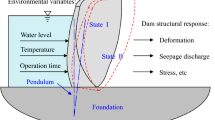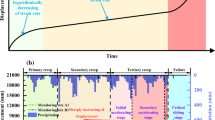Abstract
The purpose of this study is to compare the prediction performances of different commonly used data mining models for high arch dam deformation prediction during the initial operation period. Four machine learning modeling techniques, namely random forest (RF), least squares support vector machines (LS-SVM), simple boosted regression tree (SBRT), kernel extreme learning machine (K-ELM), and modified statistical models are used. With the help of hierarchical clustering on principal component analysis, the typically measured temperatures representing the unsteady dam temperature field are selected to reduce dimensionality, avoid over-fit, and facilitate explanation. The practical term for the time-dependent effect, reflecting both the exponential growth and the recovery term, is also introduced. These models are constructed, and their prediction and explanatory capabilities to model dam deformation are compared by dividing time series into training and test sets. Four different training and test combinations are investigated. The traditional hydrostatic–seasonal–time (HST) model is not enough to predict this nonlinear deformation. The SBRT, the modified HST, and its improved HTTTS (hydrostatic–thermal by measured temperature–time–season model) models show good performance. Relative influence and partial dependence plot are employed to understand the relationship between the deformation and the predictor variables. The results show that several factors, including reservoir thermal stratification, concrete temperature rise, valley contraction, and non-monotonic time-dependent effect, affect the deformation of high arch dams during the initial operation period.












Similar content being viewed by others
References
Habib P (1987) The Malpasset dam failure. Eng Geol 24:295–329
Hu J, Ma F (2020) Statistical modelling for high arch dam deformation during the initial impoundment period. Struct Control Health 27(12):e2638
Mohammad A (2018) A study on structural safety of concrete arch dams during construction and operation phases. Geotech Geol Eng 37:571–591
Prakash G, Sadhu A, Narasimhan S, Brehe JM (2018) Initial service life data towards structural health monitoring of a concrete arch dam. Struct Control Health 25:e2036
Yigit CO, Alcay S, Ceylan A (2016) Displacement response of a concrete arch dam to seasonal temperature fluctuations and reservoir level rise during the first filling period: evidence from geodetic data. Geomat Nat Haz Risk 7:1489–1505
Wang R (2016) Key technologies in the design and construction of 300 m ultra-high arch dams. Engineering 2(3):350–359
Cheng L, Liu YR, Yang Q, Pan YW, Lv Z (2017) Mechanism and numerical simulation of reservoir slope deformation during impounding of high arch dams based on nonlinear FEM. Comput Geotech 81:143–154
Li B, Xu J, Xu W, Wang H, Yan L, Meng Q, Xie W (2020) Mechanism of valley narrowing deformation during reservoir filling of a high arch dam. Eur J Environ Civ Eng. https://doi.org/10.1080/19648189.2020.1763843
Matos D, Gomes Tavares de C, Faria AA, Figueiredo J (2018) Observation of the behaviour of Foz Tua dam during the first filling of the reservoir. Third International Dam World Confreence, pp. 1–10
Li Q, Zuo Z, Hu Y, Liang G (2017) Smart monitoring of a super high arch dam during the first reservoir-filling phase. J Aerosp Eng 30(2):B4016001
Hu J, Ma F, Wu S (2018) Anomaly identification of foundation uplift pressures of gravity dams based on DTW and LOF. Struct Control Health 25(5):e2153
Salazar F, Morán R, Toledo MÁ, Oñate E (2017) Data-based models for the prediction of dam behaviour: a review and some methodological considerations. Arch Comput Method Eng 24:1–21
Nguyen LH, Goulet JA (2018) Structural health monitoring with dependence on non-harmonic periodic hidden covariates. Eng Struct 166:187–194
Kang F, Li J, Dai J (2019) Prediction of long-term temperature effect in structural health monitoring of concrete dams using support vector machines with Jaya optimizer and salp swarm algorithms. Adv Eng Softw 131:60–76
Mata J, de Castro AT, da Costa JS (2017) Constructing statistical models for arch dam deformation. Struct Control Health 21:423–437
Santillán D, Salete E, Toledo MÁ (2015) A new 1D analytical model for computing the thermal field of concrete dams due to the environmental actions. Appl Therm Eng 85:160–171
Santillan D, Salete E, Toledo MÁ (2015) A methodology for the assessment of the effect of climate change on the thermal-strain–stress behaviour of structures. Eng Struct 92:123–141
Tatin M, Briffaut M, Dufour F, Simon A, Fabre JP (2018) Statistical modelling of thermal displacements for concrete dams: Influence of water temperature profile and dam thickness profile. Eng Struct 165:63–75
Salazar F, Toledo MÁ, Oñate E, Morán R (2015) An empirical comparison of machine learning techniques for dam behaviour modelling. Struct Saf 56:9–17
Hu J, Ma F (2020) Zoned deformation prediction model for super high arch dams using hierarchical clustering and panel data. Eng Comput 37(9):2999–3021
Su H, Chen Z, Wen Z (2016) Performance improvement method of support vector machine-based model monitoring dam safety. Struct Control Health 23:252–266
Ranković V, Grujović N, Divac D, Milivojević N (2014) Development of support vector regression identification model for prediction of dam structural behavior. Struct Saf 48:33–39
Bui KTT, Bui T, Zou J, Van DC, Revhaug I (2018) A novel hybrid artificial intelligent approach based on neural fuzzy inference model and particle swarm optimization for horizontal displacement modeling of hydropower dam. Neural Comput Appl 29:1495–1506
Kang F, Liu J, Li J, Li S (2017) Concrete dam deformation prediction model for health monitoring based on extreme learning machine. Struct Control Health 24(10):e1997
Salazar F, Toledo MÁ, Oñate E, Suárez B (2016) Interpretation of dam deformation and leakage with boosted regression trees. Eng Struct 119:230–251
Li X, Wen Z, Su H (2021) An approach using random forest intelligent algorithm to construct a monitoring model for dam safety. Eng Comput 37:39–56
Belmokre A, Mihoubi MK, Santillán D (2019) Analysis of dam behavior by statistical models: application of the random forest approach. KSCE J Civ Eng 23:4800–4811
Li M, Wang J (2019) An empirical comparison of multiple linear regression and artificial neural network for concrete dam deformation modelling. Math Probl Eng 2019:7620948
Han BP, Armengol J, Garcia JC, Comerma M, Roura M, Dolz J, Straskraba M (2000) The thermal structure of Sau Reservoir (NE: Spain): a simulation approach. Ecol Model 123:9–122
Diao W, Cheng YG, Zhang CZ, Wu J (2015) Three-dimensional prediction of reservoir water temperature by the lattice Boltzmann method: validation. J Hydrodyn Ser B 27:248–256
Granato D, Santos Jânio S, Escher GB, Ferreira BL, Maggioc RM (2018) Use of principal component analysis (PCA) and hierarchical cluster analysis (HCA) for multivariate association between bioactive compounds and functional properties in foods: a critical perspective. Trends Food Sci Tech 72:83–90
Verbanck M, Josse J, Husson F (2015) Regularised PCA to denoise and visualise data. Stat Comput 25:471–486
Abdi H, Williams LJ (2010) Principal component analysis. WIREs Comp Stat 2(4):433–459
Léger P, Leclerc M (2007) Hydrostatic, temperature, time-displacement model for concrete dams. J Eng Mech 133:267–277
Li F, Wang Z, Liu G, Fu C, Wang J (2015) Hydrostatic seasonal state model for monitoring data analysis of concrete dams. Struct Infrastruct E 11(12):1616–1631
Hu J, Wu S (2019) Statistical modeling for deformation analysis of concrete arch dams with influential horizontal cracks. Struct Health Monit 18:546–562
Wang J, Hu J (2015) A robust combination approach for short-term wind speed forecasting and analysis—combination of the ARIMA (autoregressive integrated moving average), ELM (extreme learning machine), SVM (support vector machine) and LS-SVM (least square svm) forecasts using a GPR (Gaussian process regression) model. Energy 93:41–56
Huang GB, Zhou H, Ding X, Zhang R (2012) Extreme learning machine for regression and multiclass classification. IEEE T Syst Man Cybern B 42(2):513–529
Greenwell BM (2017) Pdp: an r package for constructing partial dependence plots. R J 9(1):421–436
Bell Laboratories (2019) The R project for statistical computing (R Version 3.3.4). https://www.r-project.org, Accessed 12 July 2019
Xu Y, Brownjohn JMW (2018) Review of machine-vision based methodologies for displacement measurement in civil structures. J Civ Struct Health 8:91–110
Santillán D, Salete E, Vicente DJ, Toledo MÁ (2014) Treatment of solar radiation by spatial and temporal discretization for modeling the thermal response of arch dams. J Eng Mech 140(11):05014001
Zhu BF (1999) Thermal stresses and temperature control of mass concrete, 2nd edn. China Electric Power Press, Beijing
Acknowledgements
This research was funded by the National Natural Science Foundation of China (NSFC) (SN: 51879169), the National Key R & D Program of China (SN: 2018YFC0406705). The observation data provided by the Changjiang Three Gorges Project Development Corporation are gratefully acknowledged.
Author information
Authors and Affiliations
Corresponding author
Ethics declarations
Conflict of interest
The authors declare that they have no conflict of interest.
Additional information
Publisher's Note
Springer Nature remains neutral with regard to jurisdictional claims in published maps and institutional affiliations.
Rights and permissions
About this article
Cite this article
Hu, J., Ma, F. Comparison of hierarchical clustering based deformation prediction models for high arch dams during the initial operation period. J Civil Struct Health Monit 11, 897–914 (2021). https://doi.org/10.1007/s13349-021-00487-8
Received:
Revised:
Accepted:
Published:
Issue Date:
DOI: https://doi.org/10.1007/s13349-021-00487-8




